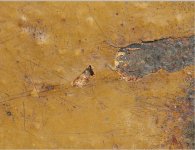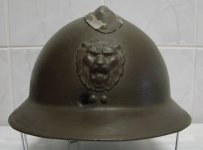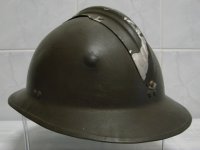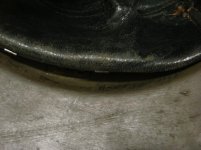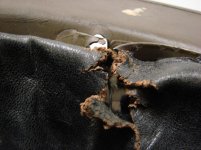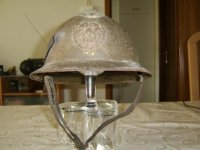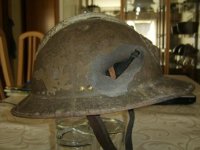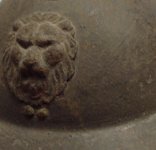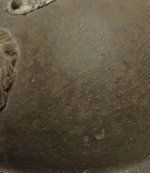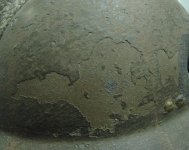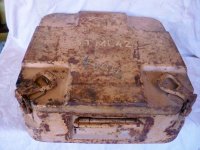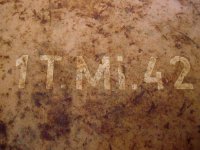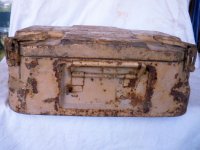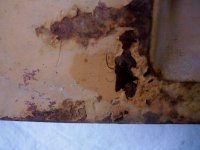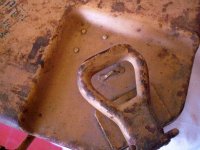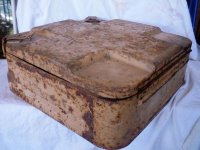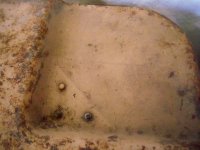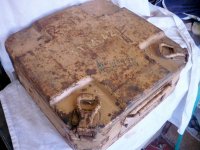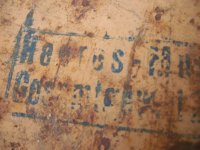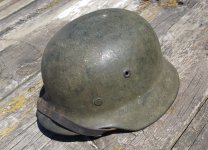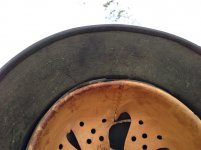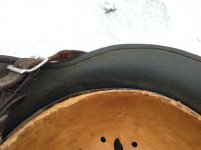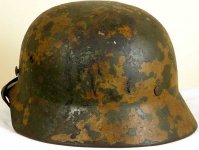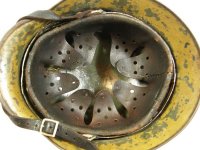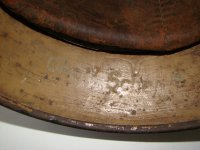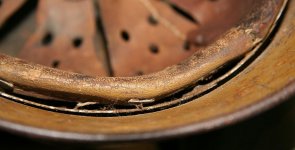
You are using an out of date browser. It may not display this or other websites correctly.
You should upgrade or use an alternative browser.
You should upgrade or use an alternative browser.
M.35 Luftwaffe "tropical" camo
- Thread starter Hambone
- Start date
Hello,
serious question from an ignorant WWI sniper collector.
Why should the Germans have painted the inside of a helmet in tan?
That does not make sense to me.
This is like painting the inside of a tiger tank in ambush camo or wearing camo underwear!?
Or is it just that simple that the Germans wanted to get rid of their camo paint and did not want to pollute the desert?
Thanks
Wolfgang
Wolfgang, it's not uncommon on documented original camo helmets for the rims to be painted too. It certainly is common on reworked and overpainted helmets. Paint has other purposes than camouflage, particularly on steel. Steel is painted to provide a protective coat. Your example assumes that they would "camo" the inside of the rim, i.e., "ambush camo paint the inside of a tiger tank". They certainly painted and overpainted the insides of tanks, though not to camouflage them. I've not seen the inside rims "camo painted" to conceal the rim as much as painted to protect the steel from rust. Put another way, if you are overpainting helmets to camo them and protect or rework them, why not use the same paint on the inside of the rim? Certainly German M.35s which were reworked from parade finish to dull finish had the skirts painted over. Certainly the same was done with tan overpaints, camo overpaints, and even whitewashed helmets.
Hello,
and on this photo it looks like the helmet was already heavily rusted when it was overpainted.
Folks, I do not question your knowledge and/or experience! But that is what I see.
Thanks
Wolfgang
Wolfgang, ever see what happens to a car when it has a chip in the paint? Does that rust stay right there in that chipped area? Note that an auto body is much more prepared against rust than a helmet. It sounds like you have limited experience with rust and painted steel surfaces or German helmets which have been stored in less than ideal environments. I have seen, owned, and own plenty of German helmets which have rusted and have paint and decals bubbled up from rust. I'm looking at a KM right now in my office with bubbled up factory paint and bubbled up decal from rust. I worked on ships and in industrial tank farms for years and much of my jobs involved painting and repainting steel surfaces. Sometimes I had to repaint the same surfaces in a single year. Any breaks in paint will cause moisture to be trapped and rust to grow and spread under the paint, particularly if you give it 70 years.
Rust, oxidation, forms quickly and will spread. If you look at the helmets in the capture pile you will see damaged surfaces on those helmets. If you placed those helmets from 1943 in an environment with any humidity, changing temperature, such as a non-climate controlled house, attic, garage, shed, barn, etc., where extremes in temperature occur, this causes condensation and rust is going to form quickly on those places where the paint protection is gone and the steel is exposed. That rust will migrate under the paint and bubble it up. Also, if there were even traces of rust, even remnants such as brown spots, painted over, moisture or condensation will develop and cause rust. Condensation from changing temperatures, moisture, etc., on steel can develop under paint which will also cause rust, which spreads quickly, even in a day.
What I suggest is this: Research the issues of whether the Germans did or did not paint the inside rims of their helmets and provide citation to authority, evidence, etc., to support your premise that this is incorrect and post it here. Because, in my 30 years of collecting I know for a fact that they did do this. We have irrefutable evidence that the Germans did this, and did it with tan helmets like this
Next, research the issue of rust and oxidation of painted steel surfaces. If your premise is that this helmet is incorrect because you believe that it was painted over a rusted surface and that the rust in the voids in the paint could only be caused by that, support your premise. Dueling subjective opinions are much like watching a dog chase its tail while barking. It's amusing for a moment, but then it gets boring and is a useless act which amuses only the dog doing the chasing
Last edited:
jack944
Senior Member
Bubbles..
I have a car that is 5 years old with bubbling paint.....this one is like many camo's that had nicks and scratches before it was repainted. Rust is pretty persistent..
Look at some of the spots on the helmet where the paint is raised from below. These "spots" on the paint are lighter from abrasion. That is what I look for with real aging.
I have a car that is 5 years old with bubbling paint.....this one is like many camo's that had nicks and scratches before it was repainted. Rust is pretty persistent..
Look at some of the spots on the helmet where the paint is raised from below. These "spots" on the paint are lighter from abrasion. That is what I look for with real aging.
Last edited:
Hello,
I do not want to research the paint or overpaint of German helmets or the issue of rust and oxidation of painted steel surfaces, because I’m not interested in that stuff.
I’ve asked a simple question, and pointed out my observations.
If you feel insulted, I’m very sorry about that.
Thanks
Wolfgang
I do not want to research the paint or overpaint of German helmets or the issue of rust and oxidation of painted steel surfaces, because I’m not interested in that stuff.
I’ve asked a simple question, and pointed out my observations.
If you feel insulted, I’m very sorry about that.
Thanks
Wolfgang
Yep. Wolfgang's scrutiny and cynicism is warranted. "Afrika Korps camos" are the most faked around. They've been faked since the 1950s. Could one take a rusty helmet, artificially age it, then bury it for a year or so and achieve a similar appearance? I'm sure they could. However, one must look at the entirety of the helmet, importantly the wear patterns, age, use, liner components, and look for signs of fiddling and fakery. Gradual and accumulated wear and age on a helmet from being used by a soldier in the field for several years, even a year, and stored for 70 more years is much difference from the wear and age that a faker puts on quickly. Look closely in the sunlight at an original German combat helmet that was actually worn and used for an extended period of time. Use a magnifying glass. Don't focus on one bubbled up area, look at all of it. These helmets show similar wear and age.
Hello,
I do not want to research the paint or overpaint of German helmets or the issue of rust and oxidation of painted steel surfaces, because I’m not interested in that stuff.
I’ve asked a simple question, and pointed out my observations.
If you feel insulted, I’m very sorry about that.
Thanks
Wolfgang
I'm not insulted, I welcome such questions as stated. I simply suggested that you research these issues if they are of interest and if they don't support my opinions on those issues, post them up. Subjective opinions without citation or factual support, mine included, are more in the nature of sphincters than facts or developed knowledge. Everyone has a sphincter.
Last edited:
Hi Amberg,
Overpainting helmets wasn't only done by the Germans in WW2, also the Belgian army did it during the mobilization in '39/'40.
Belgian M31 helmet has a shiny factory khaki green paint finish just like the applegreen German DD M35, vehicle paint was put on the helmets and also the inside rim was overpainted.
This are to well documented M31 helmets in my collection; on the helmet of Capt-Cmdt Montjardin you can even see paint drips/strips on the liner.
Cheers,
Peter
Overpainting helmets wasn't only done by the Germans in WW2, also the Belgian army did it during the mobilization in '39/'40.
Belgian M31 helmet has a shiny factory khaki green paint finish just like the applegreen German DD M35, vehicle paint was put on the helmets and also the inside rim was overpainted.
This are to well documented M31 helmets in my collection; on the helmet of Capt-Cmdt Montjardin you can even see paint drips/strips on the liner.
Cheers,
Peter
Attachments
I'm not insulted, I welcome such questions as stated. I simply suggested that you research these issues if they are of interest and if they don't support my opinions on those issues, post them up. Subjective opinions without citation or factual support, mine included, are more in the nature of sphincters than facts or developed knowledge. Everyone has a sphincter.
Hello,
please keep in mind that my native language is not the same as yours. It takes some time for me to translate some phrases.
That wasn't cynicism from my side! Maybe a bit! ;-) Just a question.
Have enough trouble to collect the German WWI sniper scopes and rifles. No need for me to study the lids.
Just my observations.
Thanks
Wolfgang
Hello,
please keep in mind that my native language is not the same as yours. It takes some time for me to translate some phrases.
That wasn't cynicism from my side! Maybe a bit! ;-) Just a question.
Have enough trouble to collect the German WWI sniper scopes and rifles. No need for me to study the lids.
Just my observations.
Thanks
Wolfgang
No problem, and no insult was intended. Our goal here is to produce accurate information and have meaningful discussions and fun. If that means questioning the originality of my artifacts or opinions, that's fine. My opinions and positions are questioned for a living
Per Wolfgang's inquiry, which was a good one, re rust under paint. Below is a standard German carrier for mines. That's the factory paint over a primer coat under it as seen inside. It's probably been better prepared to hold up to bad conditions than a helmet with that primer coat. It hasn't been stored outside, but it was not stored in ideal circumstances either, likely in a non-climate controlled warehouse with temperature fluctuations. Notice the rust patterns and migration.
On a helmet, did it sit in a capture pile, in a ditch, on a grave, or in a field for a week before it was collected as a trophy? A month?
On a helmet, did it sit in a capture pile, in a ditch, on a grave, or in a field for a week before it was collected as a trophy? A month?
Attachments
Hello,
sorry, but that is normal rust.
What I wanted to point out is shown the the attached photo. It looks like there are rust bubbles unter the tan paint, where the surface of the paint is not damaged.
Two more questions please.
Did only the Luftwaffe paint the inside of the lids in tan?
Do you know any other German helmet camo that was applied to the inside as well?
Thanks
Wolfgang
sorry, but that is normal rust.
What I wanted to point out is shown the the attached photo. It looks like there are rust bubbles unter the tan paint, where the surface of the paint is not damaged.
Two more questions please.
Did only the Luftwaffe paint the inside of the lids in tan?
Do you know any other German helmet camo that was applied to the inside as well?
Thanks
Wolfgang
Attachments
Bigdibbs88
"Ach du lieber!"
no it wasnt specific to a certain branch, just depended on the individual that painted it and with what. here is my M40 Heer lid with painted rim...
I dont know much about helmets, but what HB said can be used for most things, including K98s, dont get caught up in one detail and miss the whole picture.
I dont know much about helmets, but what HB said can be used for most things, including K98s, dont get caught up in one detail and miss the whole picture.
Attachments
Hello,
sorry, but that is normal rust.
What I wanted to point out is shown the the attached photo. It looks like there are rust bubbles unter the tan paint, where the surface of the paint is not damaged.
Two more questions please.
Did only the Luftwaffe paint the inside of the lids in tan?
Do you know any other German helmet camo that was applied to the inside as well?
Thanks
Wolfgang
Do you know that is rust under those spots and not dirt, globs of paint, etc.? I don't and it's my helmet. Soldiers overpainting helmets probably did so with less care than say, professional painters at an auto body repair shop. Again, rust can and does regularly form on steel under paint for various reasons, including if the steel sweats, i.e., due to improper storage, temperature changes, etc. My answer about painting the inside of rims is exactly the same as it was before and I am as sure that the inside of rims were painted as I am sure that somewhere the sun shines. Again, my suggestion is the same: I know my answer from my real life experience, observations, knowledge, science, and the facts and I've provided you my answer based upon those.
Asking the same questions over and over again is not going to change my answer to you if you are asking a question, and is not going to change my opinion. If you wish to change my answer and opinion, research the issue fully and present your citations to studies, authority, and evidence that rust cannot form on steel under paint and that Germans did not paint the inside rims of their helmets when painting the tops. Here are a couple more Heer and Luft lid rims, one with the name painted over it......
Attachments
Last edited:
Do you know that is rust under those spots and not dirt, globs of paint, etc.?
Asking the same questions over and over again is not going to change my answer to you if you are asking a question, and is not going to change my opinion.
NO! I do NOT know that it is rust under those spots. That is why I said " it looks like .....".
What question did I ask OVER AND OVER AGAIN?
You are pissed at me. Why? Only because I dared to asked a simple question?
NO! I do NOT know that it is rust under those spots. That is why I said " it looks like .....".
What question did I ask OVER AND OVER AGAIN?
You are pissed at me. Why? Only because I dared to asked a simple question?
Please. You asked these questions again and I answered them again. My response is the same. I'm not going to go scraping on this helmet with a knife or screwdriver to see what's under those bumps in the paint. I'm not pissed at you at all, you seem upset with my answers. So, again, if you don't accept my opinions, then research the issue of rust under paint and paint on German helmet rims and provide intelligent citations to authority and reasoned responses as to why my answers are unacceptable. I'll gladly change my opinion if you show me. The ammo can was not repainted. That's factory paint. So how did rust get under the paint? The factory didnt paint a brand new rusty mine can.
Also: Thanks Bigd, cool helmet, with the rim painted
Last edited:
Hello Amberg,
Did only the Luftwaffe paint the inside of the lids in tan?
- No, every branch of the German army did it.
Do you know any other German helmet camo that was applied to the inside as well?
- Yes, I have seen plenty of them.
And yes that could be rust underneeth the camo paint.
Are this good enough answers to your simple questions?
Regards,
P
PS: btw I'am not pissed either.
Did only the Luftwaffe paint the inside of the lids in tan?
- No, every branch of the German army did it.
Do you know any other German helmet camo that was applied to the inside as well?
- Yes, I have seen plenty of them.
And yes that could be rust underneeth the camo paint.
Are this good enough answers to your simple questions?
Regards,
P
PS: btw I'am not pissed either.
no it wasnt specific to a certain branch, just depended on the individual that painted it and with what. here is my M40 Heer lid with painted rim...
I dont know much about helmets, but what HB said can be used for most things, including K98s, dont get caught up in one detail and miss the whole picture.
Danke,
hätte nicht gedacht dass die so einen Stuss gemacht haben.
Gruß
Hello Amberg,
Did only the Luftwaffe paint the inside of the lids in tan?
- No, every branch of the German army did it.
Do you know any other German helmet camo that was applied to the inside as well?
- Yes, I have seen plenty of them.
And yes that could be rust underneeth the camo paint.
Are this good enough answers to your simple questions?
Regards,
P
PS: btw I'am not pissed either.
Think so.
Thanks



